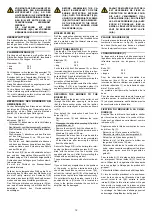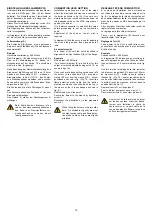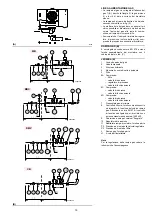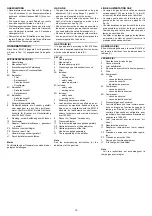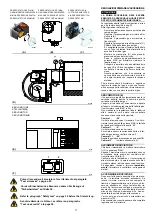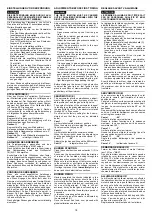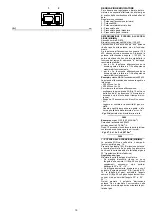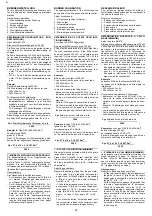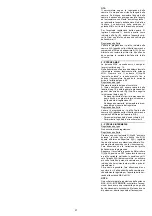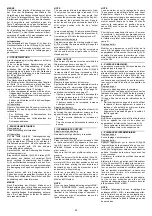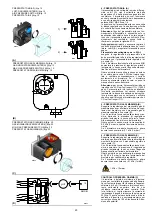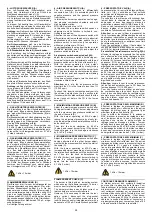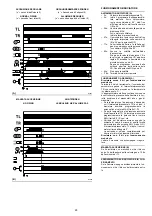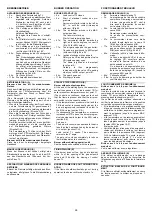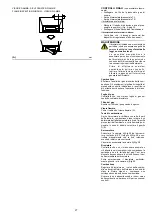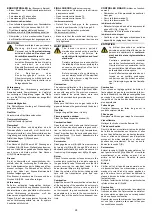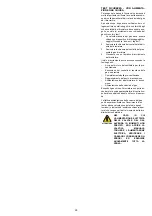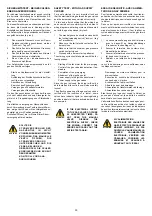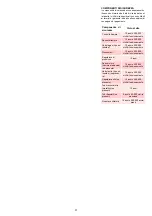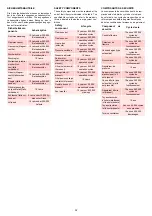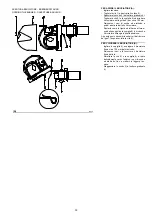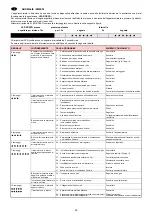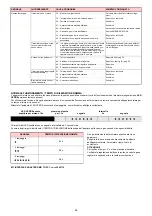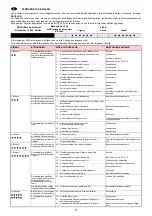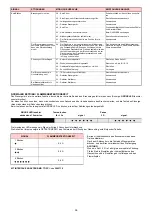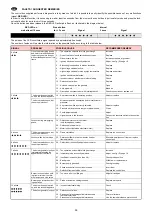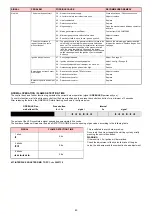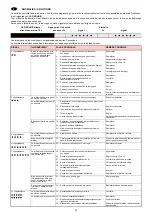
26
BRENNERBETRIEB
ANFAHREN DES BRENNERS (A)
• 0s:
Abschalten Fernsteuerung TL.
• 2s:
Das Programm des elektrischen Steu-
ergerätes wird aufgerufen.
Anfahren
Stellmotor: dreht um 90° nach dreht,
d.h. heißt bis zum Eingriff des Schalt-
stücks am Nokken I (E)S.24.
• 26s:
Die Luftklappe positioniert sich auf
Höchstleistung.
Anfahren Gebläsemotor.
Es beginnt die Phase der Vorbelüf-
tung.
• 57s:
Der Stellmotor rechts nach links, bis
zum am Nocken III (E)S. 24 eingestell-
ten Winkel, für die Mindestleistung.
• 77s:
Die Luftklappe und die Gasdrossel
positionieren sich auf Mindestleistung
(mit Nocken III (E)S.24 auf 65°.
• 92s:
Funkenbildung an der Zündungselek-
trode.
Das Sicherheitsmagnetventil VS und
das Regelventil VR, schnellöffnend, öff-
nen sich und es erfolgt eine Flammen-
bildung mit niedriger Leistung, Punkt A.
Es erfolgt eine progressive Steige-
rung des Durchsatzes, mit langsamer
Öffnung des Ventils VR bis zur Min-
destleistung, Punkt B.
• 94s:
Der Funke erlischt.
• 118s: Die Anlaufphase ist beendet.
BETRIEBLEISTUNG (A)
Brenner ohne den Kit für modulierenden
Betrieb
Nach dem Anfahrzyklus geht die Steuerung des
Stellmotors zur TR-Fernsteuerung über, die
Temperatur oder den Druck im Kessel über-
wacht, Punkt C.
(Das Steuergerät überwacht weiterhin die
Flamme und die richtige Stellung der Luft- und
Gas- Höchstdruckwächter).
• Wenn die Temperatur oder der Druck niedrig
und die Fernsteuerung TR geschlossen ist,
steigert der Brenner die Leistung stufenweise
bis zur Höchstleistung, (Strecke C-D).
• Wenn die Temperatur oder der Druck dann
bis zur Öffnung von TR steigt, senkt der Bren-
ner die Leistung stufenweise bis zur Mindest-
leistung, (Strecke E-F), u.s.w.
• Der Brenner schaltet sich auf, wenn der Wär-
mebedarf geringer ist, als die vom Brenner
auf
Mindestleistung
gelieferte
Wärme
(Strecke G-H).
Die Fernsteuerung TL öffnet sich, der Stell-
motor geht auf 0° Winkel zurück. Die Klappe
schließt ganz und beschrankt den Wärmever-
lust auf ein Minimum.
Brenner mit Kit für modulierenden Betrieb
Siehe das dem Leistungsregler beigefugte
Handbuch.
MANGELNDE ZÜNDUNG (B)
Wenn der Brenner nicht zündet, erfolgt eine
Störabschaltung innerhalb von 3s ab dem Öff-
nen des Gasventils und 108s nach der Ver-
schluß des TL.
ABSCHALTUNG WÄHREND DES BRENNER-
BETRIEBS
Erlischt die Flamme zufällig während des Bren-
nerbetriebs, erfolgt nach 1s die Störabschaltung
des Brenners.
BURNER OPERATION
BURNER START-UP (A)
• 0s:
Load control TL closes.
• 2s:
Start of electrical control box pro-
gramme.
Servomotor starts: rotate to the left by
90°, i.e. until the contact intervenes
with cam I (E)p.24.
• 26s:
The air damper arrives to the MAX.
output position.
The fan motor starts up.
Start of the pre-purging phase.
• 57s:
The servomotor rotates towards the
right, as far as the angle set on cam III
(E)p. 24 for MIN. output.
• 77s:
The air gate valve and the gas butter-
fly valve are positioned to MIN output
(with cam III)(E)p.24 a 65°.
• 92s:
Ignition electrode strikes a spark.
Safety valve VS and adjustment valve
VR (rapid opening) open.
The flame is ignited at a low output
level, point A.
Delivery
is
then
progressively
increased, with the valve VR opening
slowly up to MIN. output, point B.
• 94s:
The spark goes out.
• 118s: Starting cycle ends.
STEADY STATE OPERATION (A)
Burner without output regulator
At the end of the starting cycle, the servomotor
control then passes to the load control TR for
boiler pressure or temperature control, point C.
(The control box continues, however, to check
that the flame is present and that the air pres-
sure switch is in the correct position)
• If the temperature or pressure is low (and the
TR load control is consequently closed), the
burner progressively increases its output to
the MAX. value, (section C-D).
• If subsequently the temperature or pressure
increases until TR opens, the burner progres-
sively decreases its output to the MIN. value
(section E-F).
And so on.
• The burner locks out when demand for heat is
less than the heat supplied by the burner at
min. output, (section G-H).
Load control TL opens. The servomotor
returns to the 0° angle.
The gate valve closes completely to reduce
thermal dispersion to a minimum.
Burner with modulating operation kit
See the handbook enclosed with the regulator.
FIRING FAILURE (B)
If the burner does not fire, it goes into lock-out
within 3s of the opening of the gas solenoid
valve and 108s after the closing of control
device TL.
BURNER FLAME GOES OUT DURING OPER-
ATION
If the flame should accidentally go out during
operation, the burner will lock out within 1s.
FONCTIONNEMENT BRULEUR
DEMARRAGE BRULEUR (A)
• 0s:
Fermeture télécommande TL.
• 2s:
Le programme de la boîte de contrôle
commence.
Démarrage servomoteur:
il tourne vers gauche de 90°, c’est à
dire jusqu'à l'intervention du contact
sur la came I (E)p.24.
• 26s:
Le volet d'air se positionne sur la puis-
sance MAX.
Démarrage moteur ventilateur.
La phase de préventilation com-
mence.
• 57s:
Le servomoteur tourne vers droite
jusqu'à l'angle réglé sur la came III
(E)p.24 pour la puissance MIN.
• 77s:
Le volet de l'air et le papillon réglage
gaz se positionnent sur la puissance
MIN (avec came III)(E)p. 24 a 65°.
• 92s:
L'étincelle jaillit de l'électrode d'allu-
mage.
La vanne de sécurité VS et la vanne
de réglage VR, ouverture rapide,
s'ouvrent; la flamme s'allume à une
petite puissance, point A.
On a ensuite une augmentation pro-
gressive du puissance, ouverture lente
de la vanne de réglage VR, jusqu'à la
puissance MIN, point B.
• 94s:
L'étincelle s'éteint.
• 118s: Le cycle de démarrage du boîtier de
contrôle s'achève.
FONCTIONNEMENT DE REGIME (A)
Brûleur sans le kit pour fonctionnement
modulant
Une fois le cycle de mise en marche terminé, la
commande du servomoteur passe à la télécom-
mande TR qui contrôle la température ou la
pression dans la chaudière, point C.
(Le coffret de sécurité continue néanmoins à
vérifier la présence de la flamme et la position
correcte des pressostats air et gaz maximum).
• Si la température ou la pressionsont basses
et que par conséquent la télécommande TR
est fermée, le brûleur augmente progressive-
ment la puissance jusqu’à la valeur MAX,
(segment C-D).
• si la température ou la pression augmentent
ensuite jusqu’à l’ouverture de TR, le brûleur
réduit progressivement la puissance jusqu’à
la valeur MIN, (segment E-F).
Et ainsi de suite.
• L'arrêt du brûleur a lieu quand la demande de
chaleur est inférieure à celle qui est fournie
par le brûleur à la puissance MIN, (segment
G-H). La télécommande TL s'ouvre, le servo-
moteur retourne à l'angle 0°. Le volet se
ferme complètement pour réduire au mini-
mum les dispersions de chaleur.
Brûleur avec le kit pour fonctionnement
modulant
Voir le manuel fourni avec le régulateur.
ABSENCE D'ALLUMAGE (B)
Si le brûleur ne s'allume pas, on a le blocage
dans un délai de 3s à partir de l'ouverture de
l'électrovanne gaz et de 108s après la fermeture
de TL.
EXTINCTION BRULEUR EN FONCTIONNE-
MENT
Si la flamme s'éteint accidentellement en cours
de fonctionnement, le brûleur se bloque en 1
seconde.

